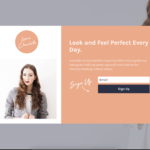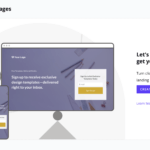What are landing pages?
A landing page is a standalone web page that is specifically designed to convert visitors into leads or customers. It is usually created as a part of a marketing campaign and is used to drive traffic from various sources such as social media, email marketing, or paid advertising. The purpose of a landing page is to provide a clear and concise message that resonates with the target audience and encourages them to take a specific action, such as filling out a form, making a purchase, or downloading a resource. A well-designed landing page can significantly increase the conversion rate of your marketing campaigns and help you maximize your ad spend.
Why are they important for conversions?
Landing pages are crucial for conversions because they are the first point of contact between a potential customer and your brand. A well-designed landing page can make a lasting impression and encourage visitors to take action, whether that’s making a purchase, filling out a form, or signing up for a newsletter. By creating landing pages that are tailored to specific audiences and goals, you can increase the likelihood of conversions and ultimately drive more revenue for your business. Additionally, landing pages provide valuable data and insights into customer behavior, allowing you to optimize your marketing strategy and improve your overall ROI.
Different types of landing pages
Different types of landing pages serve different purposes and can be used for various marketing campaigns. For example, a lead generation landing page is designed to capture contact information from potential customers, while a click-through landing page aims to persuade visitors to click through to another page, such as a product page. A sales landing page is focused on converting visitors into customers by highlighting the benefits and features of a product or service. Additionally, a splash page is a type of landing page that is used to promote a specific event or offer. It’s important to choose the right type of landing page for your campaign to maximize your ad spend and drive conversions.
Key elements of a landing page
The key elements of a landing page are crucial to its success in driving conversions. Firstly, the headline should be clear and attention-grabbing, conveying the main benefit of the product or service being offered. Secondly, the body copy should be concise and persuasive, highlighting the unique selling points and addressing any potential objections. Thirdly, the call-to-action should be prominent and compelling, guiding the user towards the desired action. Additionally, the design and layout of the landing page should be visually appealing and easy to navigate, with relevant images and videos to enhance the user experience. By incorporating these key elements, you can create a landing page that maximizes your ad spend and drives conversions.
Best practices for design and layout
When it comes to designing your landing page, simplicity is key. A cluttered page can be overwhelming and distract from the main goal of driving conversions. Use a clear and concise headline that clearly communicates the value proposition of your product or service. Make sure your call-to-action (CTA) is prominently displayed and stands out from the rest of the page. Use high-quality images and videos that are relevant to your product or service and help to visually communicate your message. Finally, make sure your page is mobile-friendly and loads quickly to ensure a seamless user experience. By following these best practices, you can create a landing page that not only looks great but also drives conversions.
How to optimize for mobile devices
With the increasing use of mobile devices, it’s crucial to optimize your landing pages for mobile users. To do this, make sure your page is responsive and loads quickly on mobile devices. Use a clear and concise headline, and keep your content short and to the point. Use bullet points and images to break up the text and make it easier to read. Also, make sure your call-to-action (CTA) is easy to find and use. Consider using a mobile-specific CTA, such as a click-to-call button or a form that’s optimized for mobile devices. By optimizing your landing pages for mobile, you’ll be able to reach a wider audience and increase your conversions.
The importance of headlines and subheadings
The importance of headlines and subheadings cannot be overstated when it comes to creating effective landing pages. Headlines are the first thing that visitors see when they arrive on your page, and they need to be attention-grabbing and relevant to the content on the page. Subheadings, on the other hand, help to break up the text and make it easier to read, while also providing additional context and information. By crafting compelling headlines and subheadings, you can capture your visitors’ attention and keep them engaged with your content, ultimately leading to higher conversion rates.
How to write persuasive copy
When it comes to writing persuasive copy for your landing page, it’s important to keep your audience in mind. Start by identifying their pain points and needs, and then craft your copy to address those concerns. Use clear and concise language, and focus on the benefits of your product or service rather than just its features. Use social proof, such as customer testimonials or statistics, to build credibility and trust with your audience. And don’t forget to include a strong call-to-action that encourages visitors to take the next step, whether that’s making a purchase or filling out a form. With these tips in mind, you can create copy that resonates with your audience and drives conversions.
Using images and videos to enhance your message
Using images and videos on your landing pages can be a powerful way to enhance your message and increase conversions. Visual content can help to break up text and make your page more engaging, while also providing a clear and concise way to communicate your value proposition. When selecting images and videos, it’s important to choose ones that are high-quality, relevant to your message, and visually appealing. You can also use videos to demonstrate your product or service in action, which can be particularly effective for complex or technical offerings. Just be sure to keep your videos short and to the point, as viewers may lose interest if they are too long or rambling. Overall, incorporating visual content into your landing pages can help to capture your audience’s attention and drive more conversions.
Understanding the conversion funnel
Understanding the conversion funnel is crucial for creating effective landing pages that drive conversions. The conversion funnel is a visual representation of the customer journey, from initial awareness of a product or service to the final purchase decision. It consists of four stages: awareness, interest, desire, and action. Each stage requires a different approach to messaging and design in order to guide the customer towards the next step in the funnel. By understanding the conversion funnel and tailoring landing pages to each stage, businesses can maximize their ad spend and increase their conversion rates.
How to use A/B testing to improve performance
A/B testing is a powerful tool that can help you optimize your landing pages for maximum conversions. By creating two versions of your landing page and testing them against each other, you can identify which elements are working and which ones need improvement. To get the most out of your A/B testing, it’s important to focus on one element at a time, such as the headline, call-to-action, or images. Be sure to track your results carefully and make changes based on the data you collect. With a little patience and persistence, A/B testing can help you create landing pages that drive conversions and maximize your ad spend.
Tracking and analyzing your landing page metrics
Tracking and analyzing your landing page metrics is crucial to understanding the effectiveness of your ad spend. By monitoring metrics such as bounce rate, time on page, and conversion rate, you can identify areas for improvement and make data-driven decisions to optimize your landing pages. It’s important to regularly review your metrics and make adjustments to your landing pages as needed to ensure that you’re getting the most out of your ad spend. Additionally, tracking your metrics over time can help you identify trends and patterns that can inform your overall marketing strategy. By taking a data-driven approach to your landing pages, you can maximize your ad spend and drive more conversions.
How landing pages can improve your ROI
Landing pages are an essential component of any successful digital marketing campaign. By creating a targeted landing page, you can increase the relevance of your ad and improve the user experience for your visitors. This, in turn, can lead to higher conversion rates and a better return on investment (ROI). A well-designed landing page can also help you to track and measure the effectiveness of your ad campaigns, allowing you to make data-driven decisions about where to allocate your ad spend. Ultimately, investing time and resources into creating effective landing pages can pay off in a big way, helping you to maximize your ad spend and achieve your marketing goals.
The impact of ad relevance on landing page performance
The relevance of your ad to your landing page is crucial for driving conversions. If your ad promises one thing and your landing page delivers something else, your visitors will quickly lose interest and leave. To ensure ad relevance, make sure your landing page is consistent with your ad copy and messaging. Use the same language, tone, and visuals to create a seamless experience for your visitors. By doing so, you’ll not only improve your conversion rates but also increase the quality score of your ads, which can lower your cost per click and improve your ad rank.
Using landing pages to target specific audiences
Using landing pages to target specific audiences is a highly effective strategy for maximizing your ad spend. By creating landing pages that are tailored to the interests and needs of a particular audience segment, you can increase the relevance and appeal of your messaging, and drive higher conversion rates. To do this effectively, it’s important to understand the characteristics and preferences of your target audience, and to design your landing page content and layout accordingly. This might involve using language and imagery that resonates with their values and aspirations, highlighting the benefits of your product or service that are most relevant to them, and providing clear calls to action that align with their goals. By taking a targeted approach to landing page design, you can create a more personalized and engaging experience for your audience, and ultimately drive better results for your business.
Popular landing page builders and platforms
There are several popular landing page builders and platforms available in the market that can help you create effective landing pages. One of the most popular ones is Unbounce, which offers a drag-and-drop interface and a wide range of templates to choose from. Another popular option is Leadpages, which offers a user-friendly interface and a variety of integrations with other marketing tools. Other notable options include Instapage, ClickFunnels, and HubSpot. When choosing a landing page builder or platform, it’s important to consider factors such as ease of use, customization options, and pricing.
Free and paid resources for design and copywriting
There are a plethora of resources available for both design and copywriting, both free and paid. For design, free resources include Canva, which offers a user-friendly platform for creating graphics and designs, and Unsplash, which provides high-quality stock photos for free. Paid resources include Adobe Creative Suite, which offers a wide range of design tools and software, and Shutterstock, which provides access to a vast library of stock photos and videos. For copywriting, free resources include Grammarly, which helps with grammar and spelling, and Hemingway, which offers suggestions for improving readability. Paid resources include Copyblogger, which offers courses and resources for improving copywriting skills, and ProWritingAid, which provides in-depth analysis and suggestions for improving writing.
How to choose the right tools for your business
Choosing the right tools for your business can be a daunting task, but it’s essential to ensure that your landing pages are optimized for conversions. There are many tools available in the market, ranging from free to paid options. Some popular landing page builders include Unbounce, Leadpages, and Instapage. These tools offer a range of features such as drag-and-drop editors, A/B testing, and integrations with other marketing tools. It’s important to consider your budget, the level of customization you require, and the specific features you need before selecting a tool. Additionally, it’s always a good idea to read reviews and compare different options before making a final decision.
Next Steps: Now that you have a better understanding of how to create landing pages that drive conversions, it’s time to put your knowledge into action. Start by analyzing your current landing pages and identifying areas for improvement. Then, use the tips and best practices outlined in this article to optimize your pages for maximum conversions.











